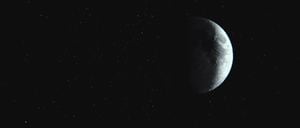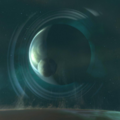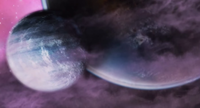Natural satellite: Difference between revisions
From Halopedia, the Halo wiki
Stryker117 (talk | contribs) m (→Gallery: spelling) |
|||
| (34 intermediate revisions by 21 users not shown) | |||
| Line 1: | Line 1: | ||
{{ | {{Status|Canon}} | ||
{{ | {{Wikipedia}} | ||
{{Center|''Looking for [[Earth]]'s moon, [[Luna]], or [[Moons (game)|moons]], the pool variant?''}} | |||
[[File: | [[File:H2A - Luna.jpg|thumb|300px|Luna, Earth's only natural satellite.]] | ||
A '''natural satellite''', | A '''natural satellite''', referred to as a '''satellite'''{{Ref/Site|D=01|M=6|Y=2020|URL=https://www.halowaypoint.com/en-us/universe/locations/earth|Site=Halo Waypoint|Page=Universe - Earth}}{{Ref/Site|D=01|M=6|Y=2020|URL=https://www.halowaypoint.com/en-us/universe/locations/alluvion|Site=Halo Waypoint|Page=Universe - Alluvion}}{{Ref/Site|D=01|M=6|Y=2020|URL=https://www.halowaypoint.com/en-us/universe/locations/mars|Site=Halo Waypoint|Page=Universe - Mars}} or '''moon''',{{Ref/Site|Id=meridian|D=01|M=6|Y=2020|URL=https://www.halowaypoint.com/en-us/universe/locations/meridian|Site=Halo Waypoint|Page=Universe - Meridian}}{{Ref/Site|Id=threshold|D=01|M=6|Y=2020|URL=https://www.halowaypoint.com/en-us/universe/locations/threshold|Site=Halo Waypoint|Page=Universe - Threshold}} is a celestial body that orbits a [[planet]] or smaller body, which is referred to as a "gravity anchor".{{Ref/Reuse|meridian}} Moons vary widely in size, surface features, or atmosphere. | ||
==Overview== | |||
Some natural satellites were only [[asteroid]]s captured by a planet's orbit, such as [[Reach]]'s smaller moon [[Turul]].{{Ref/Site|Id=moonsinfo|D=01|M=6|Y=2020|URL=http://carnage.bungie.org/haloforum/halo.forum.pl?read=1045222|Site=halo.bungie.org|Page=I've got your answer, Levi...}} Other moons are the size of planets, such as [[Basis]] which is nearly twice the size of [[Earth]].{{Ref/Site|D=01|M=6|Y=2020|URL=http://nikon.bungie.org/misc/sloftus_planetscale|Site=halo.bungie.org|Page=Halo-verse Planetary Scale}} | |||
== | There are a number of planets that have extensive systems of moons, like [[Threshold]] and its 12 satellites,{{Ref/Reuse|threshold}} or [[Vitalyevna]] and its 27 moons.{{Ref/Site|D=01|M=6|Y=2020|URL=https://www.halowaypoint.com/en-us/universe/locations?page=2|Site=Halo Waypoint|Page=Universe - Locations - Page 2}} | ||
*[[ | |||
*[[ | ==List of known moons== | ||
*[[Csodaszarvas]] | {{Main|Category:Moons}} | ||
*[[ | {{col-begin}} | ||
*[[ | {{col-3}} | ||
*[[Jovian Moons]] | *[[Epsilon Eridani system]] | ||
**[[ | **[[Tribute]] | ||
**[[ | ***[[Emese]] | ||
**[[ | **[[Reach]] | ||
**[[ | ***[[Turul]] | ||
*[[ | ***[[Csodaszarvas]] | ||
*[[ | *[[Sol system]] | ||
*[[Qikost]] | **[[Earth]] | ||
*[[ | ***[[Luna]] | ||
*[[ | **[[Jupiter]] | ||
*[[ | ***[[Jovian Moons]] | ||
*[[ | ****[[Io]] | ||
*[[ | ****[[Europa]] | ||
*[[ | ****[[Ganymede]] | ||
*[[ | ****[[Callisto]] | ||
*[[ | **[[Mars]] | ||
***[[Phobos]] | |||
**[[Saturn]] | |||
***[[Titan]] | |||
*[[51 Pegasi B]] | |||
**[[Pegasi Delta]] | |||
*[[Alluvion]] | |||
**[[Fallow]] | |||
*[[Atlas]] | |||
**[[Atlas Moons]] | |||
{{col-3}} | |||
*[[Balaho]] | |||
**[[Buwan]] | |||
**[[Padpad]] | |||
*[[Bliss]] | |||
**[[Aires]] | |||
*[[Biko]] | |||
**[[Seoba]] | |||
*[[Chu'ot]] | |||
**[[Eayn]] | |||
*[[Doisac]] | |||
**[[Soirapt]] {{C|destroyed in [[2559]]}} | |||
**[[Teash]] | |||
**[[Warial]] | |||
*[[Dokra-Movi]] | |||
**[[Feldokra]] | |||
*[[Draetheus V]] | |||
**[[X50]] {{C|an [[Orbital reformer]]}} | |||
*[[Eiro]] | |||
*[[Gao]] | |||
**[[Cenobia]] | |||
*[[Hesiod]] | |||
**[[Metisette]] | |||
*[[Hestia V]] | |||
**[[Meridian]] | |||
*[[Onyx]] | |||
**[[XF-063 IV-1]] | |||
*[[Sanghelios]] | |||
**[[Suban]] | |||
**[[Qikost]] | |||
{{Col-3}} | |||
*[[Threshold]] | |||
**[[Basis]] | |||
*[[Unidentified moon|Unidentified moon]] | |||
*[[Unidentified moon (Headhunters)|Unidentified moon]] | |||
*[[Vitalyevna]] | |||
**[[Talitsa]] | |||
**[[Komoya]] | |||
**[[Rostov]] | |||
*[[Yonhe]] | |||
{{col-end}} | |||
==Gallery== | ==Gallery== | ||
{{Linkbox|gallery=yes|gallerypage=Images of moons}} | |||
<gallery> | <gallery> | ||
File:HaloReach - ReachMoons.png|Csodaszarvas and Turul, the two natural satellites of [[Reach]]. | File:HaloReach - ReachMoons.png|[[Csodaszarvas]] and [[Turul]], the two natural satellites of [[Reach]]. | ||
File: | File:Headhunters - Moon.png|An [[Unidentified moon (Headhunters)|unidentified moon]]. | ||
File:Escalation - Alluvion.png|[[Alluvion]] with [[Fallow]] in the background | |||
</gallery> | </gallery> | ||
==Sources== | |||
{{Ref/Sources}} | |||
[[Category:Moons| ]] | [[Category:Moons| ]] | ||
[[Category:Astronomical objects]] | [[Category:Astronomical objects]] | ||
Latest revision as of 15:17, August 16, 2023
| There is more information available on this subject at Natural satellite on the English Wikipedia. |
A natural satellite, referred to as a satellite[1][2][3] or moon,[4][5] is a celestial body that orbits a planet or smaller body, which is referred to as a "gravity anchor".[4] Moons vary widely in size, surface features, or atmosphere.
Overview[edit]
Some natural satellites were only asteroids captured by a planet's orbit, such as Reach's smaller moon Turul.[6] Other moons are the size of planets, such as Basis which is nearly twice the size of Earth.[7]
There are a number of planets that have extensive systems of moons, like Threshold and its 12 satellites,[5] or Vitalyevna and its 27 moons.[8]
List of known moons[edit]
- Main article: Category:Moons
Gallery[edit]

|
Browse more images in this article's gallery page. |
Csodaszarvas and Turul, the two natural satellites of Reach.
Sources[edit]
- ^ Halo Waypoint, Universe - Earth (Retrieved on Jun 1, 2020) [archive]
- ^ Halo Waypoint, Universe - Alluvion (Retrieved on Jun 1, 2020) [archive]
- ^ Halo Waypoint, Universe - Mars (Retrieved on Jun 1, 2020) [archive]
- ^ a b Halo Waypoint, Universe - Meridian (Retrieved on Jun 1, 2020) [archive]
- ^ a b Halo Waypoint, Universe - Threshold (Retrieved on Jun 1, 2020) [archive]
- ^ halo.bungie.org, I've got your answer, Levi... (Retrieved on Jun 1, 2020) [archive]
- ^ halo.bungie.org, Halo-verse Planetary Scale (Retrieved on Jun 1, 2020) [archive]
- ^ Halo Waypoint, Universe - Locations - Page 2 (Retrieved on Jun 1, 2020) [archive]



